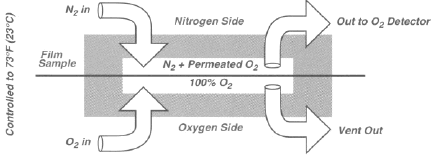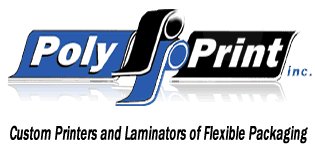Oxygen Transmission Rate
Definition
Relevance to package performance
What affects the OTR on films
Test principles
Related Terminology
Definition
OTR (oxygen transmission rate) is the steady state rate at which oxygen gas permeates through a film at specified conditions of temperature and relative humidity. Value are expressed in cc/100 in2/24 hr in US standard units and cc/m2/24 hr in metric (or SI) units. Standard test conditions are 73°F (23°C) and 0% RH.
Relevance to package performance
The air we breathe is about 21% oxygen and 79% nitrogen, with very small concentrations of other gases like carbon dioxide and argon. Essential to human and animal life, oxygen gas is also a reactive compound that is a key player in food spoilage. Most of the chemical and biological reactions that create rancid oils, molds, and flavor changes require oxygen in order to occur. So, it is not surprising that food packaging (and some non-food packaging for products where atmospheric oxygen causes harm) has progressed and found ways to reduce oxygen exposure and extend the shelf life of oxygen-sensitive products.
There are two methods for reducing product exposure to oxygen via flexible packaging.
- MAP (modified atmosphere packaging) is a process for replacing the air in the headspace of a package with another gas before the final seal is made. This is also called gas flushing. The most common replacement gases are nitrogen or nitrogen/carbon dioxide mixtures. The shelf lives of potato chips, dried fruits, nuts, and shredded cheese are commonly extended by this packaging method.
- Vacuum packaging is where the atmosphere is drawn out and eliminated, rather than being replaced by another gas. This vacuum forces the flexible material to conform to the product shape. Meats (fresh and processed) and cheeses are commonly packaged this way.
Once air has been replaced or eliminated from the package, there must be an adequate oxygen barrier and seal integrity to keep a low oxygen concentration inside the pack. Otherwise, the driving force created by the oxygen partial pressure differences (21% outside the bag and 0-2% inside the bag) will cause an ingress of oxygen and destroy the benefit of removing it in the first place. OTR values are used to compare the relative oxygen barrier capabilities of packaging films. An industry rule-of-thumb is that a material is considered a "high oxygen barrier" if its OTR is less than 1 cc/100 in2/24 hr (15.5 cc/m2/24 hr).
Table 10 shows OTR values for common polymer packaging films. Note that the table is divided into two sections. The first contains normalized (1 mil) values for common materials. The second section displays the OTRs for coated or metallized films where the total film thickness is unimportant, because the barrier is primarily coming from the additional layer.
Film Type |
OTR @ 73°F (23°C), 0% RH | |
|---|---|---|
| (cc/100 in2/24 hr) | (cc/m2/24 hr) | |
| The following OTRs are bulk material properties displayed at 1 mil. You may divide by the gauge (in mil) in order to approximate OTR at a different thickness. | ||
| EVOH* (ethylene vinyl alcohol) | .005 -.12 | .08 - .19 |
| Biax Nylon-6 | 1.2 - 2.5 | 18.6 - 39 |
| OPET (oriented polyester) | 2 - 6 | 31 - 93 |
| OPP | 100 - 160 | 1550 - 2500 |
| Cast PP | 150 - 200 | 2300 - 3100 |
| HDPE (high density polyethylene) | 150 - 200 | 2300 - 3100 |
| OPS (oriented polystyrene) | 280 - 400 | 4350 -6200 |
| LDPE (low density polyethylene) | 450 - 500 | 7000 - 8500 |
| The following OTRs are enhanced by coating or metallizing. Therefore, these are not bulk film properties, and total film thickness has little impact on the OTR value. | ||
| Metallized OPET | .01 - .11 | .16 - 1.7 |
| PVOH-coated OPP (AOH) | .02 | .31 |
| Metallized biax Nylon-6 | .05 | .78 |
| PVdC-coated OPET | .30 - .50 | 4.7 - 7.8 |
| High Barrier PVdC-coated OPP | .30 - .60 | 4.7 - 9.3 |
| PVdC-coated biax Nylon-6 | .35 - .50 | 4.7 - 7.8 |
| Metallized OPP | 1.2 - 10 | 19 - 160 |
| Sealable PVdC-coated OPP | 1.5 - 3.5 | 23 - 54 |
| Table 10: OTR values for common films | ||
| *The range of possible values is especially wide for EVOH because the value is dependent on the ethylene content of the particular grade. EVOH is typically a buried layer, either via coextrusion or lamination. | ||
CAUTION: In order for film oxygen barrier to contribute its full product protection value, package seal integrity must be satisfactory. Poor quality seals can negate a film's good barrier by allowing oxygen transmission through channel leakers and imperfections.
Related information: Many customers ask about the carbon dioxide (CO2) and nitrogen (N2) transmission rates through film. ExxonMobil does not perform transmission testing with these gases, but a value range can be estimated from OTR values by using the following relationships.
CO2 TR will be 3 to 5 times the OTR value at 73ºF (23ºC), 0% RH
N2 TR will be .2 to .4 times the OTR value at 73ºF (23ºC), 0% RH
For example, the OTR of 110 AXT is .40 cc/100 in2/24 hr @ 73ºF (23ºC), 0% RH. Therefore, at the same conditions, the CO2 TR is approximately 1.2 - 2.0 cc/100 in2/24 hr and the N2 TR is approximately .08 to .16 cc/100 in2/24 hr.
What affects the OTR of films
Good oxygen barrier is achieved by combining functional layers to create a film with the required barrier, as well as those other properties necessary to produce a serviceable package. For example, EVOH has exceptional OTR properties, but needs moisture barrier and mechanical properties provided by layers that are coextruded or laminated around it.
OTR is most affected by the following factors.
- Thickness of barrier layer: Generally, the thicker the oxygen barrier-providing layer, the better the barrier. But there are process and cost limitations that restrict the thicknesses that can be realistically produced or successfully utilized.
- Copolymer ratio, plasticizer content, and polymerization process: All PVdCs (or EVOHs or PVOHs) are not created equal. Properties are compromised during polymer and product development, so that total performance in target applications is optimized. There can be substantial differences in OTR values depending on the selections made. For example, both ASB-X and AXT are PVdC-coated and sealable, but their OTRs are 4.5 cc/100 in2/24 hr and .40 cc/1 00 in2/24 hr, respectively. ASB-X has the poorer OTR, but a broader seal range than AXT.
- Base film surface compatibility: The physical and chemical characteristics of the base film surface have a major effect on the OTR after metallization, and to a lesser degree, after coating. This is evidenced by Met PET's exceptional barrier, as well as the difference in OTRs between various metallized OPP products (refer to Table 10).
ExxonMobil only measures and controls OTR for those films that are modified through coating, coextrusion, or metallization, and guarantee a maximum OTR value in the product specification. This includes AXT, HBS-2, AOH, MET-HB, and MU842.
Test principles
ExxonMobil uses MOCON OX-TRAN@ instruments for measuring OTR. The instrument design and the way we operate the instrument are consistent with the ASTM D 3985 standard. ExxonMobil standardizes its reporting to test conditions of 73°F (23°C) and 0% RH.
Conceptually, a test cell looks like Figure 4. Dry nitrogen gas is swept through a chamber, where the test film acts as the membrane separating this stream from an oxygen stream on the other side. The partial pressure difference creates a driving force for oxygen molecules to diffuse through the film to the low pressure side. The film barrier determines the rate of oxygen permeation, and this is continuously measured by a MOCON® patented coulometric sensor in the outgoing ,stream of the nitrogen side.
 |
| Figure 4: Cross-section of an OTR test cell |
The test is complete when equilibrium, or steady state, is achieved; that is, it is complete when the sensor detects a constant amount of oxygen in the nitrogen carrier stream. The rate of oxygen permeating through the sample is not changing. This rate is the sample OTR and is recorded in units of cc/100 in2/24 hr or cc/m2/24 hr at 73°F (23°C), 0% RH.
This discussion is an overview of how ExxonMobil measures OTR and was based on articles and product literature provided by MOCON®. There is much more substance to the science and measurement of mass transfer. For more information, contact MOCON® in Minneapolis, MN at (612) 493-6370, or visit www.mocon.com.
NOTE: It is important to discuss the effects of relative humidity on OTR, even though the ASTM standard procedure is at dry conditions. Relative humidity has a dramatic and negative effect on the OTRs of some materials, most notably nylon, EVOH and PVOH. The effect is especially pronounced at RHs over about 70%. AOH, with its PVOH coating, is the only ExxonMobil oxygen-barrier film affected this way. AOH should only be used as an oxygen barrier in dry applications. Consult your ExxonMobil representative.
Related terminology
PVdC: PVdC stands for polyvinylidene chloride, but The Dow Chemical Company points out in the 2nd edition of The Wiley Encyclopedia of Packaging Technology that the use of this term is not precisely correct. PVdC suggests a homopolymer resin; when in fact, all commercial resins are VdC copolymers and should be referred to as such. Nevertheless, it is not likely that our industry will change its ways, where "PVdC" has become a generally accepted representation for the family of VdC copolymers.
Saran®: Saran® is a trademark of The Dow Chemical Company for its family of PVdC and VdC copolymer products.
Oxygen scavengers: Oxygen scavengers are materials that chemically react with oxygen in a package headspace. They can be used with MAP in order to attain very low oxygen concentrations (ppm levels) that are not achievable with MAP alone. Most oxygen scavengers used commercially are packets containing iron powders that are placed inside a package and consume headspace oxygen through oxidation reactions.

